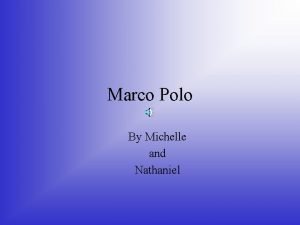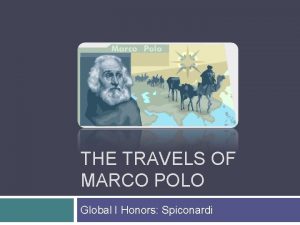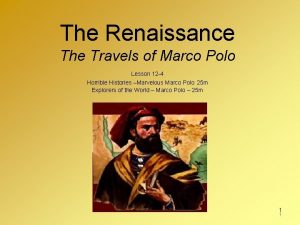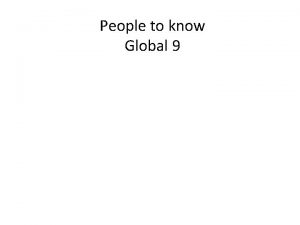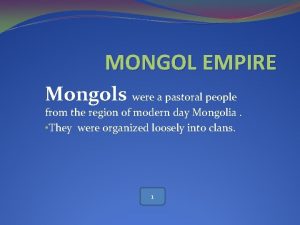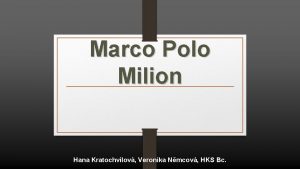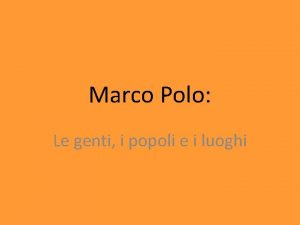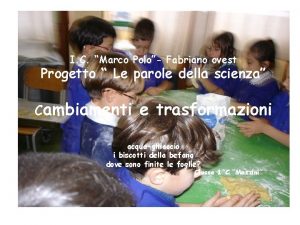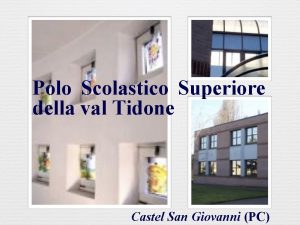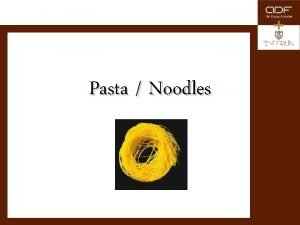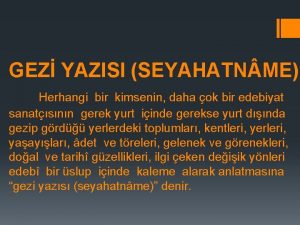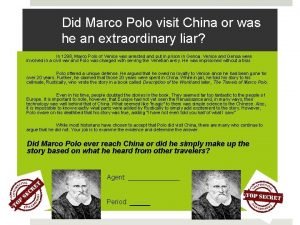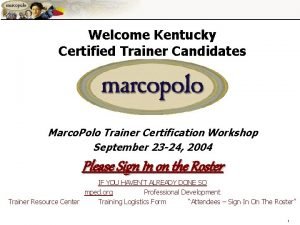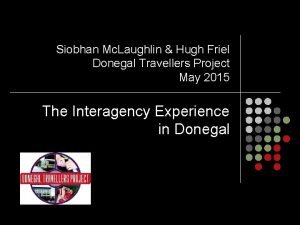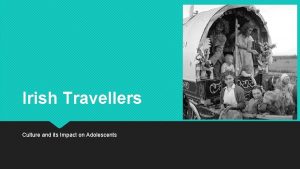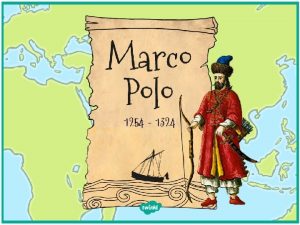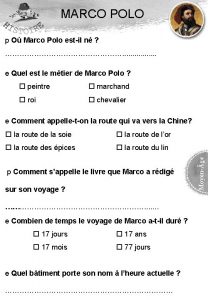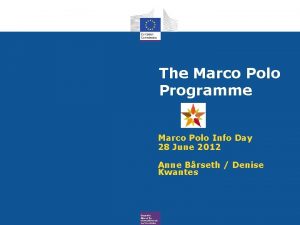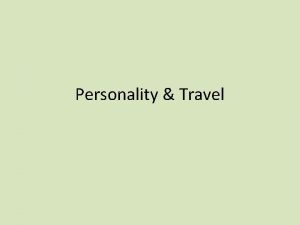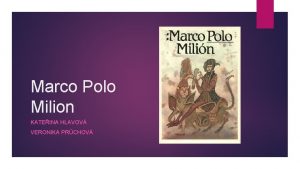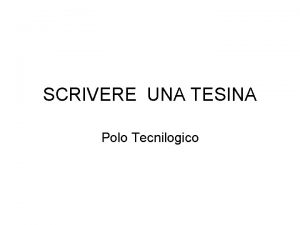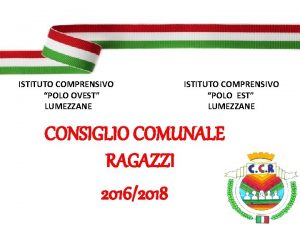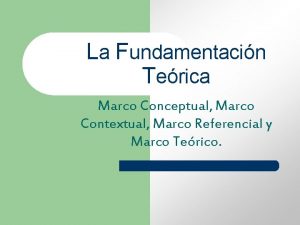The Greatest Travellers Marco Polo Early life and
















- Slides: 16

The Greatest Travellers

Marco Polo Early life and Asian travel Genoese captivity and later life Death Cartography Commemoration Further exploration

Marco Polo (1254 -1324) Marco Polo September 15, 1254 – January 9, 1324) was a Venetian merchant traveler whose travels are recorded in Il Milione, a book which did much to introduce Europeans to Central Asia and China. He learned about trading whilst his father and uncle, Niccolò and Maffeo, travelled through Asia and apparently met Kublai Khan. In 1269, they returned to Venice to meet Marco for the first time. The three of them embarked on an epic journey to Asia, returning after 24 years to find Venice at war with Genoa; Marco was imprisoned, and dictated his stories to a cellmate. He was released in 1299, became a wealthy merchant, married and had three children. He died in 1324, and was buried in San Lorenzo. His pioneering journey inspired Christopher Columbus and others. Marco Polo's other legacies include Venice Marco Polo Airport, the Marco Polo sheep, and several books and films. He also had an influence on European cartography, leading to the introduction of the Fra Mauro map.

Early life and Asian travel The exact time and place of Marco Polo's birth are unknown, and current theories are mostly conjectural. One possible place of birth is Venice's former contrada of San Giovanni Crisostomo, which is sometimes presented by historians as the birthplace, and it is generally accepted that Marco Polo was born in the Venetian Republic with most biographers pointing towards Venice itself as Marco Polo's home town. Some biographers suggest that Polo was born in the town of Korčula (Curzola), on the island of Korčula in today's Croatia, however there is no proof to this claim. The most quoted specific date of Polo's birth is somewhere "around 1254". His father Niccolò was a merchant who traded with the Middle East, becoming wealthy and achieving great prestige. Niccolò and his brother Maffeo set off on a trading voyage, before Marco was born. In 1260, Niccolò and Maffeo were residing in Constantinople when they foresaw a political change; they liquidated their assets into jewels and moved away. [8] According to The Travels of Marco Polo, they passed through much of Asia, and met with the Kublai Khan. Meanwhile, Marco Polo's mother died, and he was raised by an aunt and uncle. Polo was well educated, and learned merchant subjects including foreign currency, appraising, and the handling of cargo ships, [9] although he learned little or no Latin. In 1269, Niccolò and Maffeo returned to Venice, meeting Marco for the first time. In 1271, during the dogado of Doge Lorenzo Tiepolo, Marco Polo (at seventeen years of age), his father, and his uncle set off for Asia on the series of adventures that were later documented in Marco's book. They returned to Venice in 1295, 24 years later, with many riches and treasures. They had traveled almost 15, 000 miles (24, 000 km)

Genoese captivity and later life Upon the Polos' return to Italy, Venice was at war with Genoa. Genoese admiral Lamba D'Oria overwhelmed a Venetian fleet at the Battle of Curzola near the island of Korčula, and Polo was taken prisoner. He spent several months of his imprisonment dictating a detailed account of his travels to a fellow inmate, Rustichello da Pisa, [9] who incorporated tales of his own as well as other collected anecdotes and current affairs from China. The book soon spread throughout Europe in manuscript form, and became known as The Travels of Marco Polo. It depicts the Polos' journeys throughout Asia, giving Europeans their first comprehensive look into the inner workings of the Far East, including China, India, and Japan. While Polo's book describes paper money and the burning of coal, it fails to mention the Great Wall of China, chopsticks, and footbinding, making skeptics wonder if Marco Polo had really gone to China, or wrote his book based on hearsay. Yet, if the purpose of Polo's tales was to impress others with tales of his high esteem and fond regard in an advanced civilization, then it is possible that Polo shrewdly would omit those details that would cause his listeners to scoff at the Chinese with a sense of European superiority. However, it is more likely that information does not apply to Polo. Foot binding was extremely rare during Polo's time and was only practiced by court dancers - and did not become common even among the upper class until centuries later. The Great Walls were built to keep out northern invaders, whereas the ruling dynasty during Marco Polo's visit were those very northern invaders. Researchers note that the Great Wall familiar to us today is a Ming structure, postdating Marco Polo's travels by more than two centuries. The Yuan rulers whom Polo served, as well as the preceding Jin and Liao Empires controlled territories both north and south of today's wall, and would have no reasons to maintain any fortifications that may have remained there from the earlier dynasties. Other Europeans who traveled to Khanbaliq during the Yuan Dynasty, such as Giovanni de' Marignolli and Odoric of Pordenone, said nothing about the wall either. Finally, the hearsay theory does not explain the absence of chop stick or foot binding reports. University of Tübingen researcher Hans Ulrich Vogel stated that Polo's description of paper money and salt production supported his presence in China. Polo was finally released from captivity in August 1299, [9] and returned home to Venice, where his father and uncle had purchased a large house in the central quarter named contrada San Giovanni Crisostomo. The company continued its activities and Marco soon became a wealthy merchant. Polo financed other expeditions, but never left Venice again. In 1300, he married Donata Badoer, the daughter of Vitale Badoer, a merchant. They had three daughters, Fantina, Bellela and Moreta.

Death In 1323, Polo was confined to bed, due to illness. On January 8, 1324, despite physicians' efforts to treat him, Polo was on his deathbed. To write and certify the will, his family requested Giovanni Giustiniani, a priest of San Procolo. His wife, Donata, and his three daughters were appointed by him as co-executrices. The church was entitled by law to a portion of his estate; he approved of this and ordered that a further sum be paid to the convent of San Lorenzo, the place where he wished to be buried. [1] He also set free a "Tartar slave" who may have accompanied him from Asia. [18] He divided up the rest of his assets, including several properties, between individuals, religious institutions, and every guild and fraternity to which he belonged. He also wrote-off multiple debts including 300 lire that his sister-in-law owed him, and others for the convent of San Giovanni, San Paolo of the Order of Preachers, and a cleric named Friar Benvenuto. He ordered 220 soldi be paid to Giovanni Giustiniani for his work as a notary and his prayers. [1] The will, which was not signed by Polo, but was validated by then relevant "signum manus" rule, by which the testator only had to touch the document to make it abide to the rule of law, [19] was dated January 9, 1324. Due to the Venetian law stating that the day ends at sunset, the exact date of Marco Polo's death cannot be determined, but it was between the sunsets of January 8 and 9, 1324.

Cartography Marco Polo's travels may have had some influence on the development of European cartography, ultimately leading to the European voyages of exploration a century later. The 1453 Fra Mauro map was said by Giovanni Battista Ramusio to have been partially based on the one brought from Cathay by Marco Polo: That fine illuminated world map on parchment, which can still be seen in a large cabinet alongside the choir of their monastery (the Camaldolese monastery of San Michele di Murano) was by one of the brothers of the monastery, who took great delight in the study of cosmography, diligently drawn and copied from a most beautiful and very old nautical map and a world map that had been brought from Cathay by the most honourable Messer Marco Polo and his father. —Giovanni Battista Ramusio

Commemoration The Marco Polo sheep, a subspecies of Ovis aries, is named after the explorer, who described it during his crossing of Pamir (ancient Mount Imeon) in 1271. In 1851, a three-masted Clipper built in Saint John, New Brunswick also took his name; the Marco Polo was the first ship to sail around the world in under six months. The airport in Venice is named Venice Marco Polo Airport, and the frequent flyer program of Hong Kong flag carrier Cathay Pacific is known as the "Marco Polo Club". The travels of Marco Polo are fictionalised in Brian Oswald Donn-Byrne's Messer Marco Polo and Gary Jennings' 1984 novel The Journeyer. Polo also appears as the pivotal character in Italo Calvino's novel Invisible Cities. The 1982 television miniseries, Marco Polo, directed by Giuliano Montaldo and depicting Polo's travels, won two Emmy Awards and was nominated for six more. Marco Polo also appears as a Great Explorer in the 2008 strategy video game Civilization Revolution.

Further exploration Other lesser-known European explorers had already travelled to China, such as Giovanni da Pian del Carpine, but Polo's book meant that his journey was the first to be widely known. Christopher Columbus was inspired enough by Polo's description of the Far East to visit those lands for himself; a copy of the book was among his belongings, with handwritten annotations. Bento de Góis, inspired by Polo's writings of a Christian kingdom in the east, travelled 4, 000 miles (6, 400 km) in three years across Central Asia. He never found the kingdom, but ended his travels at the Great Wall of China in 1605, proving that Cathay was what Matteo Ricci (1552– 1610) called "China".

Amerigo Vespucci Background Expeditions Voyages: First voyage Second voyage Third voyage

Amerigo Vespucci (1454 -1512) Amerigo Vespucci (March 9, 1454 – February 22, 1512) was an Italian explorer, financier, navigator and cartographer who first demonstrated that Brazil and the West Indies did not represent Asia's eastern outskirts as initially conjectured from Columbus' voyages, but instead constituted an entirely separate landmass hitherto unknown to Afro-Eurasians. Colloquially referred to as the New World, this second super continent came to be termed "America", probably deriving its name from the feminized Latin version of Vespucci's first name.

Background Amerigo Vespucci was born and raised in Florence, Italy. He was the third son of Ser Nastagio (Anastasio), a Florentine notary, and Lisabetta Mini. Amerigo Vespucci was educated by his uncle, Fra Giorgio Antonio Vespucci, a Dominican friar of San Marco in Florence. While his elder brothers were sent to the University of Pisa to pursue scholarly careers, Amerigo Vespucci embraced a mercantile life, and was hired as a clerk by the Florentine commercial house of Medici, headed by Lorenzo de Medici. Vespucci acquired the favor and protection of Lorenzo Pierfrancesco de Medici who became the head of the business after the elder Lorenzo's death in 1492. In March 1492, the Medici dispatched the thirty-eight year old Vespucci and Donato Niccolini as confidential agents to look into the Medici branch office in Cadiz (Spain), whose managers and dealings were under suspicion. In April, 1495, by the intrigues of Bishop Juan Rodríguez de Fonseca, the Crown of Castile broke their monopoly deal with Christopher Columbus and began handing out licenses to other navigators for the West Indies. Just around this time (1495– 96), Vespucci was engaged as the executor of Giannotto Berardi, an Italian merchant who had recently died in Seville. Vespucci organized the fulfillment of Berardi's outstanding contract with the Castilian crown to provide twelve vessels for the Indies. After these were delivered, Vespucci continued as a provision contractor for Indies expeditions, and is known to have secured beef supplies for at least one (if not two) of Columbus's voyages.

Expeditions At the invitation of king Manuel I of Portugal, Vespucci participated as observer in several voyages that explored the east coast of South America between 1499 and 1502. On the first of these voyages he was aboard the ship that discovered that South America extended much further south than previously thought. The expeditions became widely known in Europe after two accounts attributed to Vespucci were published between 1502 and 1504. In 1507, Martin Waldseemüller produced a world map on which he named the new continent America after Vespucci's first name, Amerigo. In an accompanying book, Waldseemüller published one of the Vespucci accounts, which led to criticism that Vespucci was trying to upset Christopher Columbus' glory. However, the rediscovery in the 18 th century of other letters by Vespucci, primarily the Soderini Letter, has led to the view that the early published accounts could be fabrications, not by Vespucci, but by others. He died on February 22, 1512 in Seville, Spain, of an unknown cause.

First voyage A letter published in 1504 purports to be an account by Vespucci, written to Soderini, of a lengthy visit to the New World, leaving Spain in May 1497 and returning in October 1498. However, modern scholars have doubted that this voyage took place, and consider this letter a forgery. Whoever did write the letter makes several observations of native customs, including use of hammocks and sweat lodges.

Second voyage About 1499– 1500, Vespucci joined an expedition in the service of Spain, with Alonso de Ojeda (or Hojeda) as the fleet commander. The intention was to sail around the southern end of the African mainland into the Indian Ocean. After hitting land at the coast of what is now Guyana, the two seem to have separated. Vespucci sailed southward, discovering the mouth of the Amazon River and reaching 6°S, before turning around and seeing Trinidad and the Orinoco River and returning to Spain by way of Hispaniola. The letter, to Lorenzo di Pierfrancesco de' Medici, claims that Vespucci determined his longitude celestially on August 23, 1499, while on this voyage. However, that claim may be fraudulent, which could cast doubt on the letter's credibility.

Third voyage The last certain voyage of Vespucci was led by Gonçalo Coelho in 1501– 1502 in the service of Portugal. Departing from Lisbon, the fleet sailed first to Cape Verde where they met two of Pedro Álvares Cabral's ships returning from India. In a letter from Cape Verde, Vespucci says that he hopes to visit the same lands that Álvares Cabral had explored, suggesting that the intention is to sail west to Asia, as on the 14991500 voyage. On reaching the coast of Brazil, they sailed south along the coast of South America to Rio de Janeiro's bay. If his own account is to be believed, he reached the latitude of Patagonia before turning back, although this also seems doubtful, since his account does not mention the broad estuary of the Río de la Plata, which he must have seen if he had gotten that far south. Portuguese maps of South America, created after the voyage of Coelho and Vespucci, do not show any land south of present-day Cananéia at 25° S, so this may represent the southernmost extent of their voyages. After the first half of the expedition, Vespucci mapped Alpha and Beta Centauri, as well as the constellation Crux, the Southern Cross. [9] Although these stars had been known to the ancient Greeks, gradual precession had lowered them below the European horizon so that they had been forgotten. On his return to Lisbon, Vespucci wrote in a letter to d'Medici that the land masses they explored were much larger than anticipated and different from the Asia described by Ptolemy or Marco Polo and therefore, must be a New World, that is, a previously unknown fourth continent, after Europe, Asia, and Africa.
 Marco polo early life
Marco polo early life How did marco polo's mom die
How did marco polo's mom die Marco polo global
Marco polo global Marco polo lesson
Marco polo lesson Maurya accomplishments
Maurya accomplishments Kublai khan accomplishments
Kublai khan accomplishments Marco polo milion
Marco polo milion Geanta marco polo
Geanta marco polo Istituto comprensivo marco polo fabriano
Istituto comprensivo marco polo fabriano Marco polo fabriano
Marco polo fabriano Istituto comprensivo castel gandolfo
Istituto comprensivo castel gandolfo Marco polo pasta myth
Marco polo pasta myth Gezi yazısı marco polo
Gezi yazısı marco polo Marco polo liar
Marco polo liar Marco polo yahoo
Marco polo yahoo Friel
Friel Irish travellers grabbing
Irish travellers grabbing

